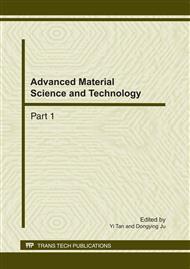p.375
p.379
p.383
p.387
p.391
p.395
p.399
p.403
p.407
Research on the Porous Structures and Properties of Composite Membranes of Polysulfone and Nanocrystalline Cellulose
Abstract:
Nanocrystalline cellulose (NCC) was used to improve hydrophilic property and permeability of polysulfone (PS) membrane. It was prepared from cellulose pulp by acid-catalyzed hydrolysis and high-pressure homogenization. The casting solution of a PS/NCC blend was obtained by adding NCC to a PS membrane solution and the composite membrane was prepared by phase-inversion method. In addition, the concentration of NCC was increased gradually from 0 wt% to 1.1 wt% during the preparation in order to examine the pure water flux and the retention of a bovine serum albumin (BSA). Simultaneously, the porosity and mean pore size of the membrane was detected and calculated. The result showed that the capacity for ultrafiltration was enhanced with appropriate NCC content. The membranes were also observed with atomic force microscopy (AFM) and scanning electron microscopy (SEM) to explore their porous structures.
Info:
Periodical:
Pages:
391-394
Citation:
Online since:
February 2011
Authors:
Price:
Сopyright:
© 2011 Trans Tech Publications Ltd. All Rights Reserved
Share:
Citation:


